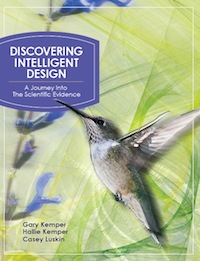 Education
Education
 Intelligent Design
Intelligent Design
Serving Teachers with the New Discovering Intelligent Design Curriculum
 Yesterday, I noted how the new Discovering Intelligent Design curriculum tries to meet the challenge of being both highly readable and highly accurate. In my own experience, finding the right balance between accuracy and readability can be a real challenge.
Yesterday, I noted how the new Discovering Intelligent Design curriculum tries to meet the challenge of being both highly readable and highly accurate. In my own experience, finding the right balance between accuracy and readability can be a real challenge.
Periodically I get opportunities to teach high school or middle school students about ID. Most recently was three weeks ago, when I taught two classes about intelligent design at a local private school. It was a beautiful sunny day, and the kids had just finished lunch and were hot and tired. On top of all of that, spring was in the air. Sitting down and thinking about science — much less intelligent design — wasn’t exactly what they were in the mood to do.
The first class I taught was definitely a below-average teaching performance on my part. So between classes I cut a few slides, honed in on the most important content, and enjoyed a caffeinated beverage. The next class was engaged and understood the material. As my teacher friends say, we were rocking it.
So how does a teacher retain the interest of kids and get them to sit down and learn about something as deep as the scientific investigation of where human beings, and the rest of life, came from? Teachers bravely face these kinds of challenges on a daily basis.
As a result, I have a huge amount of respect for teachers. They have to be “on stage” all day, every day, trying to teach kids about complex ideas. That is very demanding. The daily cycle of teaching all day, only to come home and grade and prep for the next day, can easily turn a full-time teaching job into an 80-hour workweek.
I know this well, because my family includes a number of high-achieving teachers, and some of them once showed me the video below which explains “The 6 Phases of Teaching.” It’s hilarious and communicates the marathon of stress that teachers endure over the course of a year. If you’re a teacher, watch the video if you need a good laugh.
Aside from a vacation, what many tired and stressed teachers need more than anything is a good curriculum — one that minimizes prep-time, and easily enables them to communicate information and content.
Over the years, many teachers have asked us at Discovery Institute for an introductory ID curriculum. Until the production of Discovering Intelligent Design, we always had to tell them that such a thing doesn’t exist. But this was a real need because a lot of teachers want to communicate complex ID concepts to their students, in an easy-to-understand manner, but they do not have good resources available. Teachers who wanted to teach ID had to put in a lot of work creating their own material. Now, they don’t have to do that anymore.
Discovering Intelligent Design is written in an accurate, yet easily accessible fashion. It comes with a Workbook, and a DVD, to keep students engaged and reinforce concepts. It’s the first strictly scientific curriculum to introduce the scientific evidence for intelligent design in both cosmology and biology in such a readily comprehensible manner.
If you are teacher, I hope you find Discovering Intelligent Design useful. For more resources, go here:
